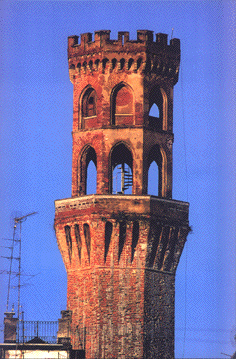The Angel's tower
| This tower is doubtless the best known as it looks out on the major square, Piazza Cavour. The square was created in the XIV century pulling down a wide area of old dilapidated houses: the tower profile is part of the view since then. Probably, the tower already belonged to an old building inhabited by an important family of Vercelli but, unfortunately, this family can't be identified. The structure is very old and it is characterized by a square base on which is placed an octagonal construction belonging to the late gothic period. The top of this construction presents typical openings called "caditoie" which were used to throw bullets to the enemies. The last part with wide windows and battlements, is probably dated back to 1875. However, the tower has already been represented in this way, but with only one range of openings, in the engraving "Theatrum Sabaudiae" (end of XVII century) which shows a bird's-eye view of the whole town. In this old engraving the tower presents a sphere over the roof and there are no battlements, because they were built during the XIX century refreshment, pulling down the original roof. Recently, it has been refurbished by the Commune (the present owner) in order to strengthen the structure after the collapse of the Pavia tower. Now, it is available for visitors even if caution is required. From the angel's tower you can enjoy a beautiful view of the historical downtown. Unfortunately, the angel's tower has never been included in the visiting tours of the town because of its precariousness, but now, thanks to the present refurbishment it will become a new tourist attraction. The tower name is linked to a folk legend which told the story of a man who threw himself from the tower and was saved by an angel. According to some other literary sources, Saint Mauro saved a man fallen from the tower in 543 A.D. but this version doesn't explain the name of the tower and even its origin would be too old. The angel's tower is one of the symbols of the town and for this reason it needs a total refurbishment both of the external walls and of the spaces inside. The nets around the tower, that prevent the fall of fragments on roofs and terraces below, could be removed after a complete renovation bringing back the tower to its original magnificence. |


Torre dell'Angelo
E' probabilmente la più nota in quanto si affaccia sulla piazza maggiore, ora piazza Cavour. Il suo snello profilo è dal XIV secolo parte integrante della veduta della piazza che, appunto, venne realizzata nel Trecento sgombrando una vasta area di case fatiscenti. La torre, certo preesistente, era forse parte dell' antico palazzo e del quartiere occupato da una importante famiglia vercellese non sicuramentee identificabile. La struttura, di origine molto antica, si imposta su di una base quadrata sulla quale si innesta un corpo ottagonale tardo gotico, concluso dalle caditoie. La sopraelevazione, con ampie finestre e merlature, si ritiene risalga al 1875, ma vediamo la torre già così raffigurata, però con un solo ordine di aperture, nell'incisione del Theatrum Sabaudiae della fine del XVII secolo che raffigura l'intera città a volo d'uccello. Nell' antica stampa la torre è riprodotta infatti con un tetto sormontato da una sfera e non sono visibili le merlature, certo frutto del rifacimento ottocentesco che la privò del tetto originale. Recentemente restaurata a cura del Comune, che ne è il proprietario, esclusivamente per consolidarne la struttura dopo il crollo improvviso della torre di Pavia, essa è percorribile e visitabile, ma solo su richiesta e con qualche difficoltà e con molta prudenza. Dalla Torre dell'Angelo si gode infatti un bellissimo panorama del centro storico vercellese. Sventuratamente la Torre dell'Angelo non è mai stata inserita nel percorso di visita della città, ma certo lo meriterebbe, dopo i necessari allestimenti e consolidamenti per renderla agibile in sicurezza. Il nome della torre pare derivi, secondo la leggenda popolare, dal miracoloso intervento di un angelo che avrebbe salvato la vita ad un uomo che salitovi si sporse e precipitò. Altre fonti di tipo letterario riportano il miracoloso intervento operato da S. Mauro su di un uomo precipitato dalla torre nell'anno 543, che però non spiegherebbe il nome assegnato alla torre e ne ricondurrebbe l'origine ad una data decisamente molto antica; forse troppo. La Torre dell'Angelo è ormai divenuta uno dei simboli della città e avrebbe necessità di un attento recupero delle superfici esterne e dell'agibilità interna. Il sistema di reti, fortunatamente poco visibili dalla piazza, che impedisce la caduta di frammenti sui tetti e terrazze sottostanti, potrebbe essere eliminato dopo un restauro definitivo e conclusivo del manto esterno in grado di riportare la torre al suo antico splendore. gs
|
![]()